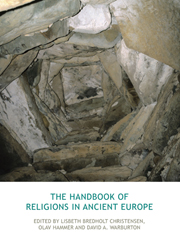Book contents
- Frontmatter
- Contents
- A note on Greek and Latin sources
- Abbreviations and short titles
- 1 Introduction
- PART I PREHISTORIC RELIGIONS
- 2 Studying prehistoric religions
- 3 Prehistoric material and religion: a personal odyssey
- 4 Francesco d'Errico and the origins of religion
- 5 On Palaeolithic religion
- 6 Ian Hodder and the Neolithic
- 7 Neolithic cult images? The testimony of figurines for Neolithic religion
- 8 Religious practices in northern Europe 4000–2000 BCE
- 9 Mythological aspects of Nordic Bronze Age religion
- 10 Religion and society in the Bronze Age
- 11 The religions of prehistoric Europe and the study of prehistoric religion
- PART II ANCIENT EUROPE IN THE HISTORICAL PERIOD
- Timeline of key dates
- Contributors
- References
- Index
3 - Prehistoric material and religion: a personal odyssey
from PART I - PREHISTORIC RELIGIONS
- Frontmatter
- Contents
- A note on Greek and Latin sources
- Abbreviations and short titles
- 1 Introduction
- PART I PREHISTORIC RELIGIONS
- 2 Studying prehistoric religions
- 3 Prehistoric material and religion: a personal odyssey
- 4 Francesco d'Errico and the origins of religion
- 5 On Palaeolithic religion
- 6 Ian Hodder and the Neolithic
- 7 Neolithic cult images? The testimony of figurines for Neolithic religion
- 8 Religious practices in northern Europe 4000–2000 BCE
- 9 Mythological aspects of Nordic Bronze Age religion
- 10 Religion and society in the Bronze Age
- 11 The religions of prehistoric Europe and the study of prehistoric religion
- PART II ANCIENT EUROPE IN THE HISTORICAL PERIOD
- Timeline of key dates
- Contributors
- References
- Index
Summary
For me, it all started with a dilemma. How was I to situate myself in a specific field – rock art studies – being personally attracted to prehistoric pictures as a visual, historical phenomenon, but sceptical of instant, un-reflected interpretations couched in terms of a stereotypical history of religion?
Among archaeologists, theories are often received as general, and not as historical products with specific time-bound qualities. Yet theories, of course, are not omnipotent, nor invariably helpful; they are social and have an agenda with claims on how the world is to be studied. My attempt to ind some expedient enabling me to avoid simple explanations – hopefully reaching a new understanding in other ways and by other means – is a complicated story.
For me, fortunately, the problem of finding a reasonable platform for discussion was not limited to an internal, archaeological discussion where the full breadth of the academic discipline of religion has never been considered. Criticism of the way archaeologists dealt with religious themes was almost non-existent. Among archaeologists, religion was much easier to handle than for scholars of religion; the reason being, however, that archaeol ogy was simply not keeping up with the discipline of the study of religion. On the other hand, being based primarily on textual sources, this latter discipline was not comfortable working with material remains and structures. This left a gap between the two disciplines, a gap which had to be bridged.
- Type
- Chapter
- Information
- The Handbook of Religions in Ancient Europe , pp. 20 - 29Publisher: Acumen PublishingPrint publication year: 2013



